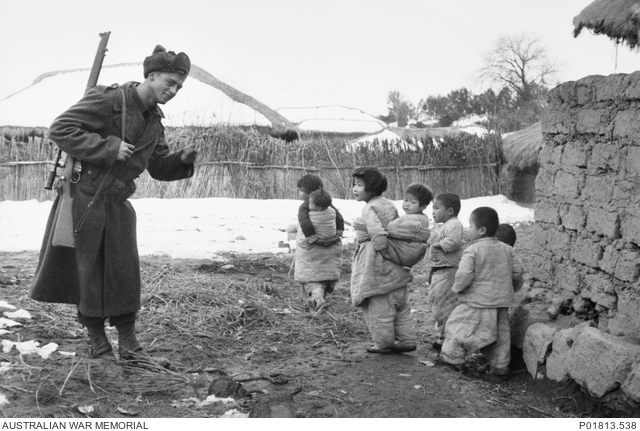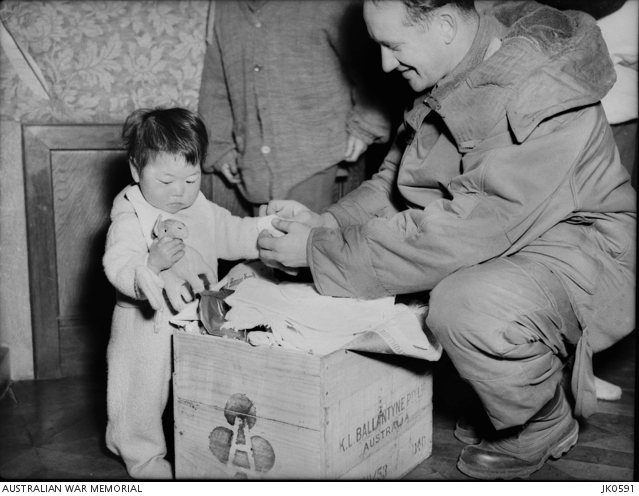Unforgotten Children
It is estimated over 100,000 Korean children were orphaned or displaced during the Korean War, separated from their parents by death, geography and poverty. They were cared for and unofficially adopted as mascots, houseboys and washboys by United Nations soldiers who provided for them while they were stationed in the country. Some children born from liaisons with United Nations service personnel were abandoned by their families and society. A lucky few were adopted by Western families in the United States and Europe after the war. Adoption agencies arose out of the ruins of the war and over 200,000 Korean children have been adopted out of the country since 1953.
Australians in the army, air force and navy regularly interacted with Korean civilians and became deeply concerned by the plight of the children. They sponsored orphanages in Seoul, gave up their rations, and held parties for children in villages near their camps and bases. The following photographs provide a glimpse into these relationships and interactions.
There will be an exhibition on display in the Memorial’s Reading Room from November 2020.
Pusan, Korea on 26 September 1950. Private William Tutton with three Korean children at the camp for Australian Force in Korean Maintenance Area, shortly after arriving in the country.
Korea, January 1951. Private Chris Bell-Chambers from the sniper section of 3RAR smiles and waves to a group of Korean children emerging from their hiding place after their village was cleared of enemy forces.
Kimpo, South Korea, 1953. Korean youngster “Jimmy” plays draughts with Leading Aircraftman Lance Lee of No. 77 Squadron, RAAF.
Private Charles Felsman, Private William Bailey and Corporal Herbert Perry send their Korean mascot "Hotrod" back to Pusan after his parents were located. Hotrod had been cared for by the Australian Field Maintenance section since it landed in Korea. The group are standing in front of a Douglas C-47 Dakota which will fly Hotrod to Pusan. Hotrod was probably one of the few who were reunited with family.
Kimpo, South Korea in 1953. Six-year-old Kim Meon Sikieh, who lives in a village near the Kimpo Airstrip, is thrilled to sit in a Gloster Meteor aircraft of No. 77 Squadron RAAF, with “Miss Bunbury” nose art.
Kim Meon Sikieh looks up at Flying Officer John Alford of No. 77 Squadron RAAF, who let him sit in his aircraft.
One of the victims of the Korean War, Chan, an orphan, salutes Corporal Edward Dowell from the Royal Australian Army Medical Corps. He holds a wooden pull along toy with a duck made by members of 1RAR for children in villages near the Jamestown Line area in June 1952.
Korea, December 1953. This winter in Korea was not the most severe the troops had experienced; they could generally count on the washing thawing out by 11 am. Privates Norman Pickford (left) and Geoffrey Birrell hold up a frozen shirt and towel. Joe, a 12-year-old Korean houseboy who works for the Australians at the 28th Brigade Headquarters, is holding up long johns.
Korea, September 1955. Lance Corporal David Coutts from 1RAR, a section commander in the anti-tank platoon, shares his haversack rations with two Korean children during a battle exercise.
Seoul, South Korea, 1953. Captain Clifford Hilton of the Salvation Army helps fit gloves to a Korean baby at the Orphan Children’s Hospital.
Kimpo, South Korea, 1953. Leading Aircraftman Robert Newton of No. 77 Squadron RAAF with Korean children orphaned during the war.
Soldiers of 1RAR put on a feast for 50 Korean orphans. Private Alpha Cashmore Hunter and another unidentified soldier from 1RAR make sure no one goes hungry. A packed audience of soldiers heard the children from the Bukhansan Orphanage in Seoul sing folk songs and English classics, and give solo piano and violin recitals.
Korea, July 1951. Private Gordon Mosey of the Australian Forces in Korea Maintenance Area bathes Pak, a Korean orphan who has been adopted by the unit, in a 44 gallon drum cut in half.
When 1RAR entertained children from nearby Korean villages on Christmas Eve 1954, goods were distributed in an assembly line system. At the end of the line, guests gathered as much as they could carry. Some guests backed up for a second and third issue, much to the amusement of soldiers who quickly detected, but did not stop, an old army trick. This young boy laden with food, including tins of treacle pudding, is assisted by an unidentified soldier.
Three is a crowd is not the order of the day when members of No. 77 Squadron RAAF visit the “George Morar” Orphanage in Kunsan, South Korea. Talking to some of the children are (left to right): Leading Aircraftman George Clifford, Corporal John O’Donnell and Padre Erskine Sweetman. The orphanage is partially supported by the men of the squadron. AWM JK0986
Two years ago the Imjin River was the scene of bitter fighting, now it is a favourite bathing spot for soldiers of 1RAR. Private Henry Yarrington takes some Korean children for a ride on his air mattress. The children belong to a group of 50 war orphans from the Bukhansan Orphanage in Seoul spending the day at the 1RAR camp.















